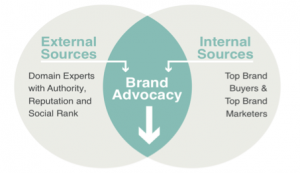As marketers, our main aim is to sway people – to create a liking for our products, to encourage support for our values, and to make them prefer our brand over competitors. Utilizing influence is the most effective and lasting tool we have in our marketing toolkit. In our new e-book, 3 Keys to Influence: Understanding and Leveraging Social Capital, we examine how to use influence to boost a brand’s social capital and positively affect key business factors like sales.
If there was any question that influence fuels word-of-mouth (WOM) and drives support for brands in social media marketing, consider the following:
- 90 percent of all purchases are subject to social influence.
- 90 percent of consumers trust recommendations from people they know.
- 67 percent of shoppers spend more money online after seeing recommendations from friends.
- Fans of brands are 51 percent more likely to buy.
We define Influence as a brand’s ability to affect or prompt action among its key constituents. We believe influence is comprised of four distinct elements. These are:
- Authority (or expertise): The degree to which a brand is widely viewed as an accepted and reliable source of information and advice on a given subject or industry, usually based on specific domain expertise. For example, Apple knows about product design, mobile devices and mobile apps.
- Reputation (or trust and integrity): The way in which a brand positions its authority. Some brands consistently share their views on a topic or industry. For example, Patagonia has a reputation for being environmentally conscious.
- Rank (usually shown as a number, like a Klout score): A brand’s reputation and authority compared to others in a certain industry or field. Rank is often used to find and prioritize, or score, online influencers. It is the main way to spot an initial group of influencers outside your brand.
- Status (or social standing): A brand’s social standing as compared to others within a particular industry or topic domain. Similar to reputation, a brand’s status in the ecosystem is affected by the consistent display of authority and reputation.
To harness influence, brands should turn to brand advocates – those who support, endorse or would personally recommend your brand to their network. Brand advocates can come from external sources, like domain experts, or internal sources, such as your top buyers.
You’ll want to weigh your business goals before defining exactly how you want to include internal and external influencers in your campaigns. Take a new product launch, for example, you’ll want both domain experts and loyal brand users to spread the word about it.
For example, when Springpad, a free app built to help people stay organized, re-launched in April of 2012, the effort was bolstered by leveraging both internal and external brand advocates. People who had previously used and loved the product used WOM and social channels to tell their world how much more they loved Springpad after the updates.
For a step-by-step guide to identifying and leveraging both internal and external influencers, plus how to run a successful advocacy campaign, download our free e-book, , 3 Keys to Influence: Understanding and Leveraging Social Capital.
We want to hear from you, marketers! How do you identify and engage influencers to drive business results? Share your thoughts and best practices with our community on Twitter (use#AwarenessTips).

